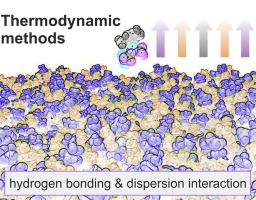Journal of Molecular Liquids ( IF 5.3 ) Pub Date : 2021-09-16 , DOI: 10.1016/j.molliq.2021.117547 Sergey P. Verevkin 1, 2 , Stanislav O. Kondratev 1 , Dzmitry H. Zaitsau 1, 2 , Kseniya V. Zherikova 3 , Ralf Ludwig 1, 2, 4

|
The attractive part of the van der Waals potential is commonly referred to as dispersion forces. Dispersion forces are a ubiquitous phenomenon with significant implications for chemistry, biochemistry, and materials science. Admittedly, the dispersion interactions are considered “weak”. For this reason, the quantification of the dispersion forces is rather challenging. In this paper we used the DFT methodology with def2-TZVPP basis set to evaluate dispersion interactions in molecular and ionic systems. We also quantify the dispersion contributions with help of the complementary to DFT experimental methods based on thermochemical quantities: standard molar vaporization enthalpy and the ideal-gas standard molar enthalpy of formation. We used a bunch of experimental thermodynamic methods (combustion calorimetry, solution calorimetry, differential scanning calorimetry, thermogravimetry, vapour pressure determination with combined Quartz Crystal Microbalance, Knudsen method, transpiration technique, static method) to quantify the dispersion forces in molecular and ionic systems. Experimental studies have been performed on the well-chosen sets of molecular compounds (alkanes, alcohols, amines, aromatics) and ionic liquids (ammonium and phosphonium based ionic liquids). The main idea was based on the predominant view that bulky groups in molecular structures are more likely considered repulsive rather than stabilizing. In view of the fact that a delicate balance between attraction and repulsion can be quantified and rationalized, the approach developed in this work can help establish new design principles based on the conscious inclusion of dispersion as an important stabilizing factor. The ensemble of experimental techniques and quantum chemical methods (DFT with D3 dispersion correction) enabled the development of quantitative scales of the dispersion contributions and their understanding at the molecular level.
中文翻译:

分子和离子系统中非共价相互作用的量化和理解:通过热力学方法分析分散相互作用和氢键
范德华势的吸引力部分通常被称为色散力。色散力是一种普遍存在的现象,对化学、生物化学和材料科学具有重要意义。诚然,色散相互作用被认为是“弱的”。因此,分散力的量化相当具有挑战性。在本文中,我们使用带有 def2-TZVPP 基组的 DFT 方法来评估分子和离子系统中的色散相互作用。我们还借助基于热化学量的 DFT 实验方法的补充来量化色散贡献:标准摩尔蒸发焓和理想气体标准摩尔形成焓。我们使用了一系列实验热力学方法(燃烧量热法、溶液量热法、差扫描量热法、热重法、蒸汽压测定结合石英晶体微天平、克努森法、蒸腾技术、静态法)来量化分子和离子系统中的分散力。对精心挑选的分子化合物(烷烃、醇、胺、芳烃)和离子液体(铵和鏻基离子液体)进行了实验研究。主要观点基于主流观点,即分子结构中的庞大基团更有可能被认为是排斥性的而不是稳定的。鉴于吸引力和排斥之间的微妙平衡可以量化和合理化,在这项工作中开发的方法可以帮助建立基于有意识地将分散作为重要稳定因素的新设计原则。实验技术和量子化学方法(具有 D3 色散校正的 DFT)的集合使色散贡献的定量尺度的发展及其在分子水平上的理解成为可能。











































 京公网安备 11010802027423号
京公网安备 11010802027423号